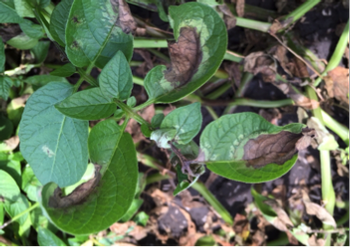Late Blight on Potatoes
-
AboutLate blight of potato was responsible for the Irish potato famine of the late 1840s. Late blight is caused by the oomycete Phytophthora infestans. Oomycetes are fungus-like organisms also called water molds, but they are not true fungi.
 Photo: Courtesy UC Regents
Photo: Courtesy UC Regents -
Category
-
Fungi
-
-
Signs/Symptoms
Lesions appear as small dark green water soaked spots, irregular in shape, surrounded by yellowish tissue. Lesions expand and become purplish tissue.
Infected tubers develop brown decay. Can spread.
-
Where
Late blight occurs commonly in coastal environments and sporadically elsewhere. The fungus inoculum can originate from seed tubers, cull piles, volunteers, closely related weed hosts, and adjacent plantings of nightshades such as potatoes or tomatoes that are affected.
-
When
High humidity (above 90%) and average temperatures in the range of 50°F to 78°F favor the disease.
-
Prevent
Use certified plants and tubers.
Keep foliage dry during growing season.
Plant certified seed tubers.
Avoid sprinkler irrigation.
Destroy all tomato, potato, eggplant, and pepper debris after harvest.
Air circulation to facilitate the drying of foliage each day is important.
-
Manage
When late blight has developed on foliage and fruit or tubers are at a risk of infection, make sure that vines have been completely dead for two to three weeks before harvest as the fungus does not survive very long in dead foliage.
-
More Information

